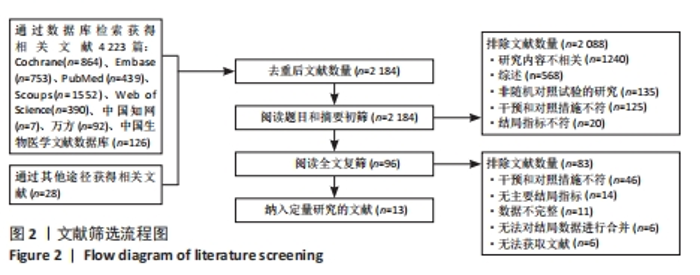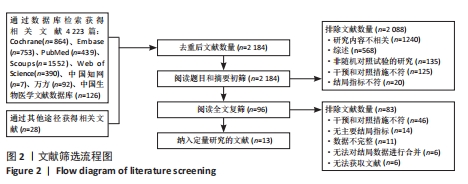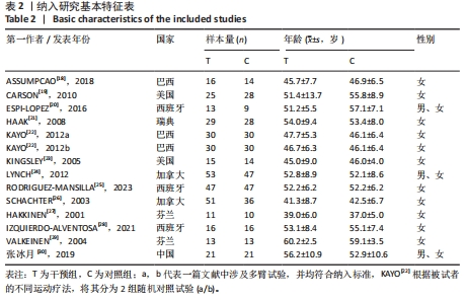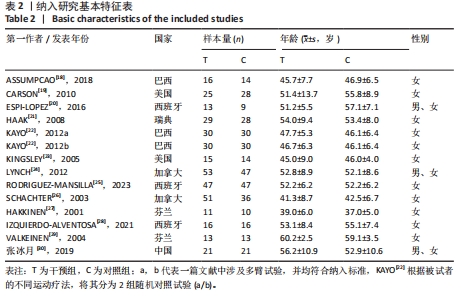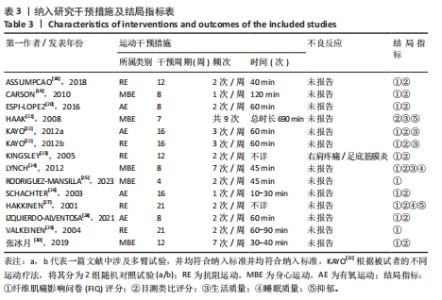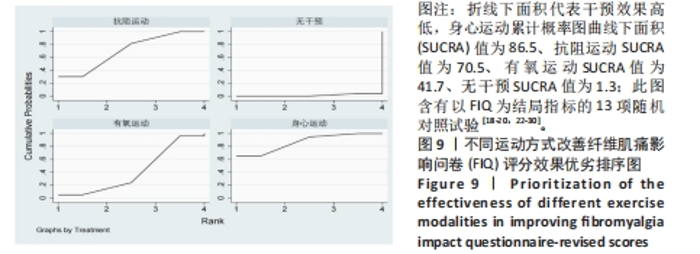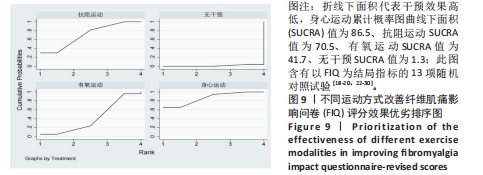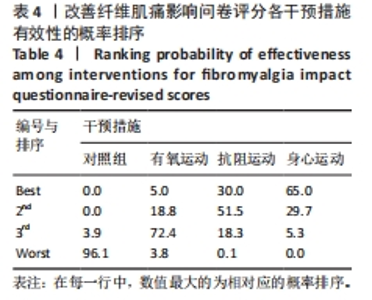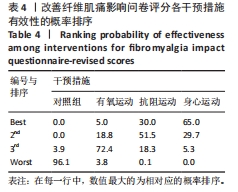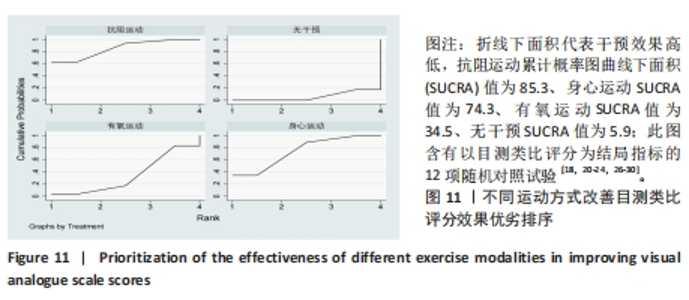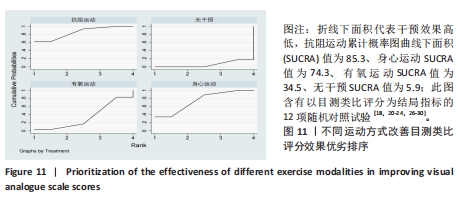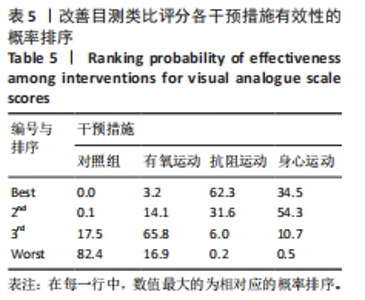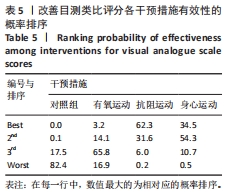Chinese Journal of Tissue Engineering Research ›› 2024, Vol. 28 ›› Issue (32): 5210-5216.doi: 10.12307/2024.519
Previous Articles Next Articles
Effectiveness of exercise interventions for fibromyalgia syndrome: a Meta-analysis
Zhang Jinpu1, Wang Junli1, Zhang Siqi2, Chen Jiahao1, Yang Qiushi1
- 1School of Physical Education, China University of Ming and Technology, Xuzhou 221116, Jiangsu Province, China; 2School of Art, Anhui Xinhua University, Hefei 230088, Anhui Province, China
-
Received:2023-09-19Accepted:2023-10-31Online:2024-11-18Published:2023-12-29 -
Contact:Wang Junli, PhD, Associate professor, Master’s supervisor, School of Physical Education, China University of Ming and Technology, Xuzhou 221116, Jiangsu Province, China -
About author:Zhang Jinpu, Master candidate, School of Physical Education, China University of Ming and Technology, Xuzhou 221116, Jiangsu Province, China -
Supported by:Major Social Science Project of Jiangsu Provincial Department of Education, No. 2021SJZDA173 (to WLJ); Graduate Innovation Program Project of China University of Mining and Technology, No. 2023WLJCRCZL180 (to ZJP)
CLC Number:
Cite this article
Zhang Jinpu, Wang Junli, Zhang Siqi, Chen Jiahao, Yang Qiushi. Effectiveness of exercise interventions for fibromyalgia syndrome: a Meta-analysis[J]. Chinese Journal of Tissue Engineering Research, 2024, 28(32): 5210-5216.
share this article
Add to citation manager EndNote|Reference Manager|ProCite|BibTeX|RefWorks

2.2 纳入研究的质量评价结果 纳入的14项随机对照试验中,有11项描述具体的随机序列产生方法[18-20,22,24-25,26,28-30],8项描述了分配隐藏[18-20,22,24-25,28],有7项对结局评价者设盲[19-20,22,25-26,28],有1项样本脱落率 > 20%[25],但未做意向治疗分析。针对其他偏倚来源,文献中均无足够信息证明其风险程度,故将其归为不确定风险。根据Cochrane风险偏倚评估工具,对纳入文献的质量进行评分,每项分为低风险、高风险及不清楚,并记为1分,0分,0.5分,> 4分认为研究偏倚风险低,≤4分认为研究偏倚风险高[31]。文章纳入的14项随机对照试验中,12项随机对照试验均在5分以上,2项随机对照试验为4.5分[21,27],偏倚风险低,在方法学的质量评价上,文献质量高。偏倚风险评估结果见图3,4。"

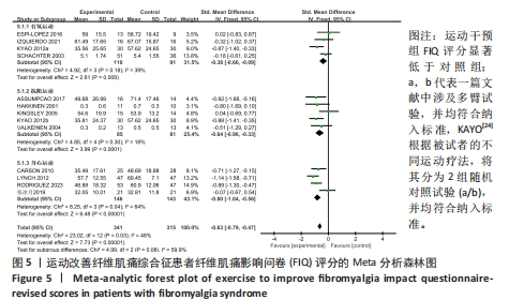
2.3 传统Meta分析结果 2.3.1 各组FIQ评分差异 13项研究报告了FIQ评分,共3种干预措施,626例受试者,试验组341例,对照组285例。有氧运动、抗阻运动以及身心运动干预措施的异质性检验分别为(I2=39%,P=0.18;I2=18%,P=0.30;I2=64%,P=0.04),说明身心运动所纳入的研究中存有一定的统计学异质性,见图5。通过对身心运动干预措施的异质性成因进行敏感性分析,发现异质性产生的主要来源可能在于某单项研究的研究设计方案不同[30]。将其剔除后各研究间无异质性(I2=0%,P=0.46)。采用固定效应模型进行效应量合并,结果显示,与无干预对照组相比,差异均有显著性意义,有氧运动(SMD= -0.38,95%CI:-0.66至-0.09,P=0.009);抗阻运动(SMD= -0.64,95%CI:-0.96至-0.33,P < 0.01);身心运动(SMD=-0.94,95%CI:-1.20至-0.68,P < 0.01);运动疗法总效应量(SMD=-0.67,95%CI:-0.83至-0.50,P < 0.01),差异有显著性意义,说明运动疗法能更显著地降低FIQ评分。"
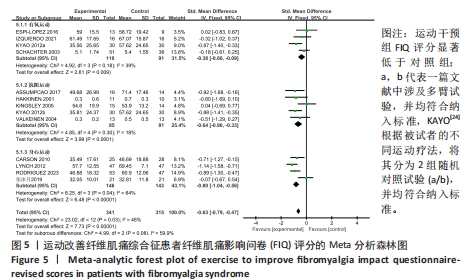
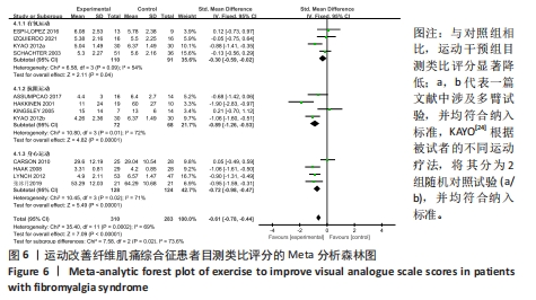
2.3.2 各组目测类比评分差异 共12项研究报告了目测类比评分,共563例受试者,试验组310例,对照组253例。这3种干预措施的异质性检验分别为(I2=54%,P=0.09;I2=72%,P=0.01;I2=71%,P=0.02),各研究间异质性较高,见图6。敏感性分析结果显示,异质性的主要来源可能在于两项研究采用的结局评价工具不同[19,23],将其剔除后,各研究间具有同质性 (P > 0.10)。采用固定效应模型进行效应量合并,与无干预对照组相比,差异均有显著性意义,有氧运动(SMD=-0.30,95%CI:-0.59至-0.02,P=0.04);抗阻运动(SMD=-1.10,95%CI:-1.50至-0.71,P < 0.01);身心运动(SMD=-0.96,95%CI:-1.25至-0.66,P < 0.01);运动疗法总效应量(SMD=-0.72,95%CI:-0.90至-0.54,P < 0.01),差异有显著性意义,说明运动疗法能更显著地降低目测类比评分。"
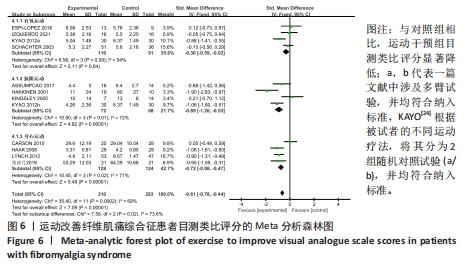

2.3.3 各组生活质量的差异 由于生活质量、睡眠质量和抑郁3个指标均属次要结局指标且纳入的研究数量较少,故不再按运动方式分型进行亚组分析。生活质量共纳入4项研究,共277例受试者,试验组142例,对照组135例。各研究间异质性大(I2=80%,P=0.002),采用随机效应模型,结果表明,试验组的生活质量改善优于对照组,差异有显著性意义(SMD=1.03,95%CI:0.45-1.61,P=0.000 5)。说明运动疗法能显著改善患者的生活质量。敏感性分析和亚组分析结果显示,异质性的来源可能在于干预措施的类型不同。 2.3.4 各组睡眠质量的差异 睡眠质量共纳入2项研究,共121例受试者,试验组64例,对照组57例。各研究间无异质性(I2=0%,P=0.44),采用固定效应模型,结果表明,试验组的睡眠质量改善优于对照组,差异有显著性意义(SMD=-0.62,95%CI:-0.98至-0.25,P=0.001),说明运动疗法能显著改善患者的睡眠质量。 2.3.5 各组抑郁症状的差异 抑郁共纳入2项研究,共78例受试者,试验组40例,对照组38例。各研究间无异质性(I2=0%,P=0.47),采用固定效应模型,结果表明,试验组的抑郁改善优于对照组,差异有显著性意义(SMD=-0.63,95%CI:-1.09至-0.18,P=0.007),说明运动疗法能显著改善患者的抑郁症状。 2.4 网状Meta分析的结果 2.4.1 研究证据网络及一致性分析结果 在传统Meta分析的基础上,对主要结局指标FIQ评分、目测类比评分进行网状Meta分析,其中FIQ评分结局指标涉及13项研究、626例样本,以目测类比评分作为结局指标共有12项研究、563例样本。各干预措施间的网状关系:圆圈面积代表所对应干预措施研究样本量的大小,连线的粗细代表两种干预措施间研究数量的多少。同时,3种运动方式干预纤维肌痛的FIQ评分、目测类比评分均通过与对照组的间接比较来实现,在网状关系中不存在闭合环,见图7,因此不需要进行一致性检验[16]。"

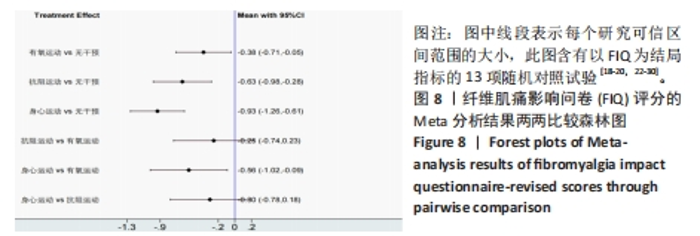
2.4.2 各组FIQ评分差异 网状Meta分析结果见图8,有氧运动、抗阻运动以及身心运动改善FIQ评分显著优于对照组,差异具有显著性意义,有氧运动(SMD=-0.38,95%CI:-0.71至-0.05)、抗阻运动(SMD=-0.63,95%CI:-0.98至-0.28)、身心运动(SMD=-0.93,95%CI:-1.26至-0.61)。两两间接比较结果显示:身心运动的效果优于有氧运动(SMD=-0.56,95%CI:-1.02至-0.09),差异有显著性意义;而其他两两间接比较之间的差异无显著性意义。利用SUCAR法,对3种运动方式干预纤维肌痛综合征患者FIQ评分的有效性进行排序:有氧运动(SUCAR值=41.7),抗阻运动(SUCAR值=70.5),身心运动(SUCAR值=86.5),无任何干预的单纯对照组(SUCAR值=1.3)。因此,干预纤维肌痛综合征患者FIQ评分有效性的可能性排序为:身心运动 > 抗阻运动 > 有氧运动,见图9和表4。"
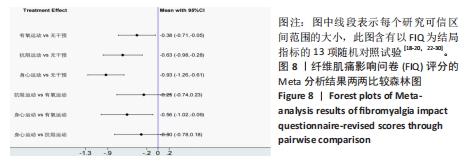

2.4.3 目测类比评分 网状Meta分析结果见图10。抗阻运动、身心运动改善目测类比评分显著优于对照组,抗阻运动(SMD=-1.12,95%CI:-1.59至-0.65)、身心运动(SMD= -0.96,95%CI:-1.34至-0.58)。而有氧运动(SMD=-0.30,95%CI:-0.65-0.06),与对照组相比,差异无显著性意义。两两间接比较结果显示:抗阻运动的效果优于有氧运动SMD= -0.82,95%CI:-1.42至-0.23);身心运动的效果优于有氧运动(SMD=-0.67,95%CI:-1.19至-0.14);而抗阻运动与身心运动的间接比较,无显著性意义。对3种运动方式改善纤维肌痛综合征患者目测类比评分的有效性进行排序:有氧运动(SUCAR值=34.5),抗阻运动(SUCAR值=85.3),身心运动(SUCAR值=74.3),无任何干预的单纯对照组(SUCAR值=5.9)。因此,干预纤维肌痛综合征患者目测类比评分有效性的可能性排序为:抗阻运动 > 身心运动 > 有氧运动,见图11和表5。"
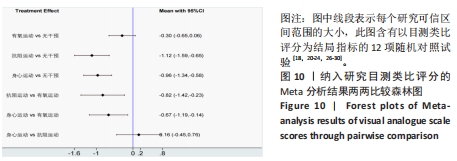
| [1] ARNOLD LM, BENNETT RM, CROFFORD LJ, et al. AAPT diagnostic criteria for fibromyalgia. J Pain. 2019;20(6):611-628. [2] 朱谦.纤维肌痛临床诊疗中国专家共识[J].中国疼痛医学杂志,2021,27(10):721-727. [3] HAUSER W, ABLIN J, FITZCHARLES MA, et al. Fibromyalgia. Nat Rev Dis Primers. 2015;1: 15022. [4] WHITE LA, ROBINSON RL, YU AP, et al. Comparison of health care use and costs in newly diagnosed and established patients with fibromyalgia. J Pain. 2009;10(9):976-983. [5] JI RR, NACKLEY A, HUH Y, et al. Neuroinflammation and central sensitization in chronic and widespread pain. Anesthesiology. 2018;129(2):343-366. [6] SARZI-PUTTINI P, GIORGI V, MAROTTO D, et al. Fibromyalgia: an update on clinical characteristics, aetiopathogenesis and treatment. Nat Rev Rheumatol. 2020;16(11): 645-660. [7] CLAUW DJ. Fibromyalgia: a clinical review. JAMA. 2014;311(15):1547-1555. [8] 梁东风,杨春花,张洁,等.度洛西汀和普瑞巴林治疗纤维肌痛的疗效和安全性对照研究[J].中国疼痛医学杂志,2023,29(3):194-200. [9] BIDONDE J, BUSCH AJ, SCHACHTER CL, et al. Aerobic exercise training for adults with fibromyalgia. Cochrane Database Syst Rev. 2017;6(6):CD012700. [10] MAESTRE-CASCALES C, CASTILLO-PAREDES A, ROMERO-PARRA N, et al. Gradual strength training improves sleep quality, physical function and pain in women with fibromyalgia. Int J Environ Res Public Health. 2022;19(23):15662. [11] ZHANG KD, WANG LY, ZHANG ZH, et al. Effect of exercise interventions on health-related quality of life in patients with fibromyalgia syndrome: a systematic review and network meta-analysis. J Pain Res. 2022;15:3639-3656. [12] MACFARLANE GJ, KRONISH C, DEAN LE, et al. EULAR revised recommendations for the management of fibromyalgia. Ann Rheum Dis. 2017;76(2):318-328. [13] 《运动处方中国专家共识(2023)》专家组.运动处方中国专家共识(2023)[J].中国运动医学杂志,2023,42(1):3-13. [14] 陈爱国,梁洪英,颜军,等.留守儿童执行功能的发育特征及身心运动干预研究[J].中国特殊教育,2016(11):69-74. [15] 刘鸣.系统评价、Meta-分析设计与实施方法[M].北京:人民卫生出版社,2011:68-71. [16] 张天嵩.高级Meta分析方法 : 基于Stata实现[M].上海:复旦大学出版社,2015:326-360. [17] SALANTI G, ADES AE, LOANNIDIS JP. Graphical methods and numerical summaries for presenting results from multiple-treatment meta-analysis: an overview and tutorial. J Clin Epidemiol. 2011;64(2):163-171. [18] ASSUMPCAO A, MATSUTANI LA, YUAN SL, et al. Muscle stretching exercises and resistance training in fibromyalgia: which is better? A three-arm randomized controlled trial. Eur J Phys Rehabil Med. 2018;54(5):663-670. [19] CARSON JW, CARSON KM, JONES KD, et al. A pilot randomized controlled trial of the Yoga of Awareness program in the management of fibromyalgia. Pain. 2010;151(2):530-539. [20] ESPI-LOPEZ GV, INGLES M, RUESCAS-NICOLAU MA, et al. Effect of low-impact aerobic exercise combined with music therapy on patients with fibromyalgia. A pilot study. Complement Ther Med. 2016;28:1-7. [21] HAAK T, SCOTT B. The effect of Qigong on fibromyalgia (FMS): a controlled randomized study. Disabil Rehabil. 2008;30(8):625-633. [22] KAYO AH, PECCIN MS, SANCHES CM, et al. Effectiveness of physical activity in reducing pain in patients with fibromyalgia: a blinded randomized clinical trial. Rheumatol Int. 2012; 32(8):2285-2292. [23] KINGSLEY JD, PANTON LB, TOOLE T, et al. The effects of a 12-week strength-training program on strength and functionality in women with fibromyalgia. Arch Phys Med Rehabil. 2005; 86(9):1713-1721. [24] LYNCH M, SAWYNOK J, HIWE C, et al. A randomized controlled trial of qigong for fibromyalgia. Arthritis Res Ther. 2012;14(4): R178. [25] RODRIGUEZ-MANSILLA J, MEJIAS-GIL A, GARRIDO-ARDILA EM, et al. Effects of an exercise for well-being and physical training programme on muscle strength, range of movement, respiratory capacity and quality of life in women with fibromyalgia: a randomized controlled trial. J Clin Med. 2023;12(3):774. [26] SCHACHTER CL, BUSCH AJ, PELOSO PM, et al. Effects of short versus long bouts of aerobic exercise in sedentary women with fibromyalgia: a randomized controlled trial. Phys Ther. 2003;83(4):340-358. [27] HAKKINEN A, HAKKINEN K, HANNONEN P, et al. Strength training induced adaptations in neuromuscular function of premenopausal women with fibromyalgia: comparison with healthy women. Ann Rheum Dis. 2001;60(1): 21-26. [28] IZQUIERDO-ALVENTOSA R, INGLES M, CORTES-AMADOR S, et al. Effectiveness of high-frequency transcranial magnetic stimulation and physical exercise in women with fibromyalgia: a randomized controlled trial. Phys Ther. 2021;101(10):pzab159. [29] VALKEINEN H, ALEN M, HANNONEN P, et al. Changes in knee extension and flexion force, EMG and functional capacity during strength training in older females with fibromyalgia and healthy controls. Rheumatology (Oxford). 2004;43(2):225-228. [30] 张冰月,夏晶,黄怡然,等.五禽戏干预纤维肌痛综合征的疗效分析[J].中国医药导刊, 2019,21(4):217-221. [31] 许瀚,尹毅,赵燕.运动干预对成人代谢综合征患者心血管危险因素影响的Meta分析[J].中国体育科技,2020,56(5):59-70. [32] LI YT, JIANG Q, JIA Y, et al. A Chinese version of the revised Fibromyalgia Impact Questionnaire: a validation study. Int J Rheum Dis. 2023;26(2):242-249. [33] 万丽,赵晴,陈军,等.疼痛评估量表应用的中国专家共识(2020版)[J].中华疼痛学杂志,2020,16(3):11. [34] BIDARI A, CHAVIDEL-PARSA B, RAJABI S, et al. The acute effect of maximal exercise on plasma beta-endorphin levels in fibromyalgia patients. Korean J Pain. 2016;29(4):249-254. [35] BOBINSKI F, FERREIRA TAA, CORDOVA MM, et al. Role of brainstem serotonin in analgesia produced by low-intensity exercise on neuropathic pain after sciatic nerve injury in mice. Pain. 2015;156(12):2595-2606. [36] LIMA LV, ABNER TSS, SLUKA KA. Does exercise increase or decrease pain? Central mechanisms underlying these two phenomena. J Physiol. 2017;595(13):4141-4150. [37] Neelapala YVR, Mercuri D, Macedo L, et al. Mechanisms hypothesized for pain-relieving effects of exercise in fibromyalgia: a scoping review. Ther Adv Musculoskelet Dis. 2023. doi:10.1177/ 1759720X231182894 [38] 臧铭,蒋佳慧,郭玮.不同运动锻炼方式延缓认知老化的研究进展[J].中国老年学杂志, 2021,41(24):5778-5782. [39] ADLER-NEAL AL, ZEIDAN F. Mindfulness meditation for fibromyalgia: mechanistic and clinical considerations. Curr Rheumatol Rep. 2017;19(9):59. [40] WANG C, SCHMID GH, FIELDING RA, et al. Effect of tai chi versus aerobic exercise for fibromyalgia: comparative effectiveness randomized controlled trial. BMJ. 2018;360: k851. [41] JONES KD. Recommendations for resistance training in patients with fibromyalgia. Arthritis Res Ther. 2015;17(1):258. [42] Nelson NL. Muscle strengthening activities and fibromyalgia: a review of pain and strength outcomes. J Bodyw Mov Ther. 2015;19(2):370-376. [43] KADETOFF D, KOSEK E. The effects of static muscular contraction on blood pressure, heart rate, pain ratings and pressure pain thresholds in healthy individuals and patients with fibromyalgia. Eur J Pain. 2007;11(1):39-47. [44] DA SILVA JM, DE BARROS BS, ALMEIDA GJ, et al. Dosage of resistance exercises in fibromyalgia: evidence synthesis for a systematic literature review up-date and meta-analysis. Rheumatol Int. 2022;42(3):413-429. [45] ANDRADE A, DE AZEVEDO KLUMB STEFFENS R, SIECZKOWSKA SM, et al. A systematic review of the effects of strength training in patients with fibromyalgia: clinical outcomes and design considerations. Adv Rheumatol. 2018;58(1):36. [46] CHEN J, HAN B, WU C. On the superiority of a combination of aerobic and resistance exercise for fibromyalgia syndrome: a network meta-analysis. Front Psychol. 2022;13:949256. [47] SOUSA M, OLIVEIRA R, BRITO JP, et al. Effects of combined training programs in individuals with fibromyalgia: a systematic review. Healthcare (Basel). 2023;11(12):1708. |
| [1] | Zhong Jun, Wang Wen. Network meta-analysis of different anatomical repair strategies to improve chronic lateral ankle instability [J]. Chinese Journal of Tissue Engineering Research, 2024, 28(9): 1470-1476. |
| [2] | Wu Jing, Yao Yingce, Yang Xiaowei, Xue Boshi, Zhao Jianbin, Yang Chen, Luan Tianfeng, Zhou Zhipeng. Intervention of muscle strength training combined with neuromuscular electrical stimulation on lower limb function and biomechanical changes in patients with patellofemoral pain [J]. Chinese Journal of Tissue Engineering Research, 2024, 28(9): 1365-1371. |
| [3] | Zhang Xiaoyun, Liu Hua, Chai Yuan, Chen Feng, Zeng Hao, Gao Zhengang, Huang Yourong. Effect of Yishen Gushu Formula on bone metabolic markers and clinical efficacyn in patients with osteoporosis of kidney deficiency and blood stasis type [J]. Chinese Journal of Tissue Engineering Research, 2024, 28(8): 1155-1160. |
| [4] | Wang Ji, Zhang Min, Li Wenbo, Yang Zhongya, Zhang Long. Effect of aerobic exercise on glycolipid metabolism, skeletal muscle inflammation and autophagy in type 2 diabetic rats [J]. Chinese Journal of Tissue Engineering Research, 2024, 28(8): 1200-1205. |
| [5] | Ma Shuwei, He Sheng, Han Bing, Zhang Liaoyun. Exosomes derived from mesenchymal stem cells in treatment of animals with acute liver failure: a meta-analysis [J]. Chinese Journal of Tissue Engineering Research, 2024, 28(7): 1137-1142. |
| [6] | Zhang Zeyi, Yang Yimin, Li Wenyan, Zhang Meizhen. Effect of foot progression angle on lower extremity kinetics of knee osteoarthritis patients of different ages: a systematic review and meta-analysis [J]. Chinese Journal of Tissue Engineering Research, 2024, 28(6): 968-975. |
| [7] | Hu Zhixing, Li Qun, Yang Chao, Wang Xiaoxiao, Fang Luochangting, Hou Wuqiong, Lin Na, Chen Weiheng, Liu Chunfang, Lin Ya. Network meta-analysis of the modeling effects of different factors on rabbit models of steroid-induced osteonecrosis of femoral head [J]. Chinese Journal of Tissue Engineering Research, 2024, 28(6): 976-984. |
| [8] | Yu Zhaoyu, Tan Lixin, Sun Kai, Lu Yao, Li Yong. Meta-analysis of cement-augmented pedicle screw for thoracolumbar degenerative diseases with osteoporosis [J]. Chinese Journal of Tissue Engineering Research, 2024, 28(5): 813-820. |
| [9] | Abuduwupuer·Haibier, Alimujiang·Yusufu, Maihemuti·Yakufu, Maimaitimin·Abulimiti, Tuerhongjiang·Abudurexiti. Meta-analysis of efficacy and safety of terlipatide and bisphosphate in the treatment of postmenopausal osteoporosis fractures [J]. Chinese Journal of Tissue Engineering Research, 2024, 28(4): 639-645. |
| [10] | Bai Xiaotian, Chen Zhaoying, Song Yiling, Wang Ye, Liu Jingmin. Effect of minimalist shoes on foot muscle morphology: systematic evaluation and Meta-analysis [J]. Chinese Journal of Tissue Engineering Research, 2024, 28(4): 646-650. |
| [11] | Wang Juan, Wang Ling, Zuo Huiwu, Zheng Cheng, Wang Guanglan, Chen Peng. Rehabilitative efficacy of kinesio taping following anterior cruciate ligament reconstruction: a Meta-analysis [J]. Chinese Journal of Tissue Engineering Research, 2024, 28(4): 651-656. |
| [12] | Su Yuying, Li Wei, Shi Yu, Pan Changbo. Effects of different exercise interventions on symptoms and dynamic balance ability of chronic ankle instability: a systematic review and Meta-analysis [J]. Chinese Journal of Tissue Engineering Research, 2024, 28(32): 5217-5224. |
| [13] | Zhang Hongsheng, Huang Hanwei, Wang Jinwu, Zheng Junwei, Liu Rixin, Liao Zijie, Wang Peng, Xu Yuanjing, Wang Zanbo, Wan Keming. Multi-criteria decision model in treatment of adolescent scoliosis with three-dimensional printed scoliosis orthosis [J]. Chinese Journal of Tissue Engineering Research, 2024, 28(30): 4806-4811. |
| [14] | Zhang Junjie, Zhou Wei, Liu Haiyuan, Guo Chenggen. A meta-analysis of the effect of post-activation potentiation on athletic performance after activation of lower-extremity relative strength levels [J]. Chinese Journal of Tissue Engineering Research, 2024, 28(28): 4586-4592. |
| [15] | Yang Liyuan, Zhang Yeting, Li Chuikun, Wei Cuilan. Effects of aerobic exercise on the expression of Notch1 and Caspase-3 in the hippocampus of Alzheimer’s disease mice [J]. Chinese Journal of Tissue Engineering Research, 2024, 28(26): 4113-4120. |
| Viewed | ||||||
|
Full text |
|
|||||
|
Abstract |
|
|||||
